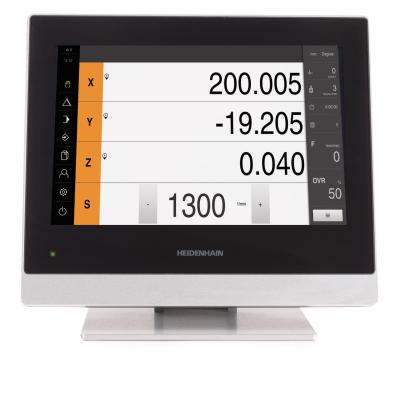
HEIDENHAIN announces the new Positip 8016 digital readout (DRO) with touch screen for manual machine tool applications. With its sturdy machined aluminum housing, this DRO promises to add reliability and ease-of-use to its milling, drilling, boring and turning jobs.
The PT 8016 DRO has a multitude of functions including a taper calculator, bolt-hole pattern routine and tool radius compensator. This DRO also includes distance-to-go modes in both absolute and incremental. It can control of up to three NC analog, point-to-point axes and a spindle with the PT 8016 “ACTIVE Version.”
This new PT 8016 DRO features a shop-hardened 12” Color TFT Touch Screen for an IP65 front panel and an IP40 back panel. Users can plug-in up to six encoders - either 1Vpp or 11µApp incremental or absolute EnDat 2.2 pure serial. It has storage for up to 100 datums and 100 tool parameters, as well as the capability to create, store and execute programs.
The PT 8016 replaces the company's long-time workhorse – the PT 880.
Contact Details
Related Glossary Terms
- boring
boring
Enlarging a hole that already has been drilled or cored. Generally, it is an operation of truing the previously drilled hole with a single-point, lathe-type tool. Boring is essentially internal turning, in that usually a single-point cutting tool forms the internal shape. Some tools are available with two cutting edges to balance cutting forces.
- gang cutting ( milling)
gang cutting ( milling)
Machining with several cutters mounted on a single arbor, generally for simultaneous cutting.
- milling
milling
Machining operation in which metal or other material is removed by applying power to a rotating cutter. In vertical milling, the cutting tool is mounted vertically on the spindle. In horizontal milling, the cutting tool is mounted horizontally, either directly on the spindle or on an arbor. Horizontal milling is further broken down into conventional milling, where the cutter rotates opposite the direction of feed, or “up” into the workpiece; and climb milling, where the cutter rotates in the direction of feed, or “down” into the workpiece. Milling operations include plane or surface milling, endmilling, facemilling, angle milling, form milling and profiling.
- numerical control ( NC)
numerical control ( NC)
Any controlled equipment that allows an operator to program its movement by entering a series of coded numbers and symbols. See CNC, computer numerical control; DNC, direct numerical control.
- turning
turning
Workpiece is held in a chuck, mounted on a face plate or secured between centers and rotated while a cutting tool, normally a single-point tool, is fed into it along its periphery or across its end or face. Takes the form of straight turning (cutting along the periphery of the workpiece); taper turning (creating a taper); step turning (turning different-size diameters on the same work); chamfering (beveling an edge or shoulder); facing (cutting on an end); turning threads (usually external but can be internal); roughing (high-volume metal removal); and finishing (final light cuts). Performed on lathes, turning centers, chucking machines, automatic screw machines and similar machines.

